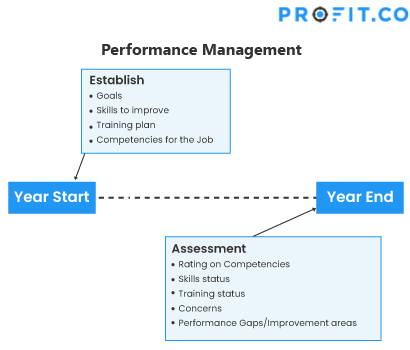Looking at the wide use of OKRs in business today, it’s clear to see that this goal management tool is as relevant today as it was more than four decades ago. Contrastingly, Performance Management initiatives such as Annual Performance Reviews have a dwindling presence in many Fortune 500 companies.
OKRs
Objectives and Key Results (OKRs) are management methods that break down a company’s objectives into time-based, achievable actions termed Key Results. OKRs have increasingly become one of the principal ways for companies to organize teams, giving them clear-cut objectives and providing an easy, actionable road map to achieve them. OKRs are usually set on a quarterly basis, but can also be utilized on an annual cycle.
Performance Management
Performance Management, or PM, on the other hand is focused on how employees perform relative to the expectations set for their grade or position. These evaluations take place annually, and are aptly called annual performance reviews. Now let’s look at the differences between OKRs & Performance Management.
Now let’s look at the differences between OKRs & Performance Management.
Key Focus
OKRs focus on business results, while performance management system focuses on how an employee performs their job.

OKRs are Business Centric. OKRs define what the business as a whole, a department, a team or an individual needs to do in a certain quarter. And how do they measure their progress towards achieving what they are trying to do. As they achieve those results, the general expectation is that the business will do better as a whole in terms of customer satisfaction, revenue, product quality, supplier satisfaction or any other factor that makes the business look and do better.

Performance reviews focus on an employee, and how their skills match up to their job requirements. The emphasis is on the employee, how to make them better at doing their current job, understanding/realigning their career aspirations periodically, helping them with their career path through coaching, training and sponsored higher studies. At the same time, identify those who significantly lack the skills to perform their job and if there is no visible path to make the job fit the employee, figure out a future course of action, including termination.
Typical Cycle
OKRs have a faster drumbeat to them. Performance reviews, generally are very involved and are typically performed once a year.

Assessment Periods
Weekly, sometimes once every 2 weeks. These reviews are called Check-ins
How does the cycle start?
- Corporate/departmental/team OKRs are established at the beginning of the quarter
- Individual OKRs are created and aligned with corporate/department/team OKRs
- Dependencies with other individuals/teams/departments are discussed and recorded through OKRs
How does the cycle end?
- At the end of the quarter teams/departments/employees conduct a
to share their learnings on how well they performed against their OKRs - For each OKR, teams/departments/employees assess where they are and if it makes sense to wrap up the OKR as is, or to extend it to the next quarter based on business needs
- Besides OKRs that get extended to the next quarter, new OKRs are added at each level again based on business needs

Assessment Periods
Once or twice a year
How does the cycle start?
- HR Department kicks off the assessment cycle
- Depending on Employee’s Grade, they receive a set of competencies that they will be rated on that is applicable to their job performance
How does the cycle end?
- HR Department kicks off the assessment cycle
- Employees perform self assessment
- 360 degree feedback obtained peers and subordinates, often kept confidential
- Manager rates the employee on competencies identified for their grade and level
- Manager & Employee meet and discuss their ratings and complete the review. Disagreements are handled through the HR department. Training opportunities are recorded
- Goals for the next review period are set
Compensation
In the software engineering department of Acmesoft Inc., John commits to delivering 10 features for a release and completed 8 of the 10 with great quality. Jacob commits to delivering 4 features for the same release, but completed 5 with great quality. Who is your pick?
OKRs
OKRs promote aggressive target setting and hence should not be used for Compensation, as the sole factor. If you do put things in perspective, it can be a great indicator.
Performance Management
Ever since HR became a business function, performance reviews and assessment has been precursor to compensation revisions.
Transparency
OKRs
OKRs promote transparency, which results in a better culture and environment where targets and achievements are also visible to everyone.
Performance Management
This is a confidential process between manager and individual employees, and remains largely undisclosed.
Incorporating both OKRs and a Performance Management System within an organization can provide a comprehensive approach to managing both business objectives and individual performance. While OKRs drive alignment and focus towards strategic goals, Performance Management Systems ensure that individuals are supported in their professional development and performance improvement. This dual approach can enhanced by the use of OKR software, can contribute to overall organizational success and growth.
